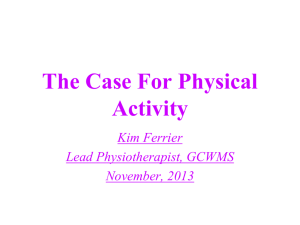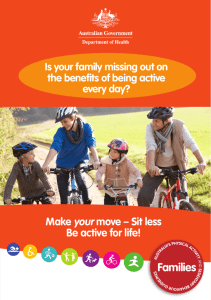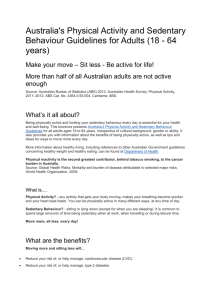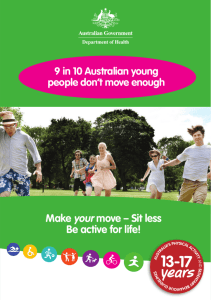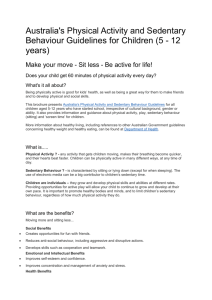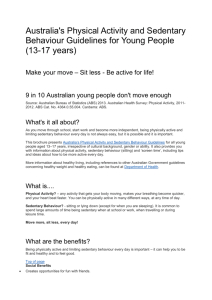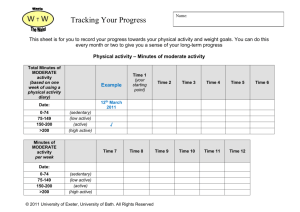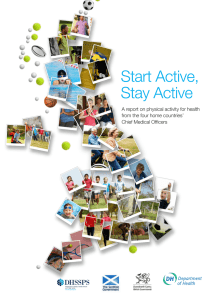New Physical Activity Guidelines for Adults and Older People
advertisement
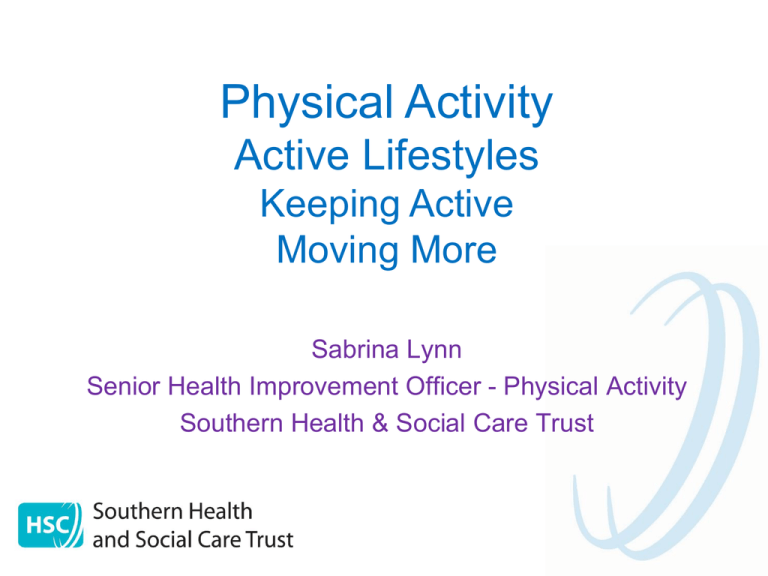
Physical Activity Active Lifestyles Keeping Active Moving More Sabrina Lynn Senior Health Improvement Officer - Physical Activity Southern Health & Social Care Trust Definitions of Physical Activity “Physical activity is all movements in everyday life, work, recreation, exercise, and sporting activities...” World Health Organisation, 1997 ‘Activities that involve movement of all the major muscle groups and the body (trunk) from one place to another.’ Start Active, Stay Active, 2011 Benefits of Physical Activity For everyone/all ages Prevent and manage over 20 chronic conditions, including coronary heart disease, stroke, type 2 diabetes, cancer, obesity, mental health problems and musculoskeletal conditions Contributes to &/maintains a healthy weight Improves self-confidence/ mood and self-esteem Children under 5 years Develops motor skills Improves cognitive development Enhances bone and muscular development Supports learning of social skills Develops movement and co-ordination Benefits of Physical Activity Children & Young People (Aged 6-18 years) Improves cardiovascular health Improves bone health Develops new social skills Adults (19-64 years) Helps maintain ability to perform everyday tasks with ease Reduces symptoms of depression and anxiety Older Adults (65+ years) Helps maintain cognitive function Helps maintain ability to carry out daily living activities Reduces the risk of falls Reduction in bone and muscle loss associated with age Physical Activity Guidelines • July 2011 • Chief Medical Officers of 4 UK home countries • 4 age groups • Importance of actvity from birth • Minimum recommendation for health 5 Key Physical Activity Messages Early Years Under 5s Under 5s who are not walking should be : Encouraged from birth to be active through Floor based & water based activity in safe environments Under 5s who are walking should aim to be active DAILY and engage in: at least 180 minutes (3 hours)* spread throughout the day *Most UK pre-school children spend 120-150 minutes a day being active – the guideline above means adding a further 30 – 60 minutes per day All Under 5s should : Minimise sedentary (restrained or sitting) periods Except time spent sleeping 6 Key Physical Activity Messages Children & Young People Aged 5 - 18 Children & young people should aim to be active DAILY and engage in: At least 60 minutes of Moderate - Vigorous physical activity & up to several hours every day For heath benefits activities should last 10 minutes or more It all adds up! 3 times a week - Vigorous intensity activity to strengthen muscle & bone Minimise sedentary (sitting) periods 7 Key Physical Activity Messages Adults aged 19 – 64 years Adults should aim to be active DAILY and achieve at least: 150 minutes of moderate physical activity over a week * Or simply 30 minutes on most days of the week (at least 5 days) For heath benefits activities should last 10 minutes or more It all adds up! 2 times a week - Activity to improve muscle strength Minimise sedentary (sitting) periods *For those already active at a moderate intensity , comparable benefits can be achieved through 75 minutes of vigorous intensity activity/week or a combination of moderate & vigorous 8 Key Physical Activity Messages Older Adults aged 65+ Older Adults should aim to be active DAILY and achieve at least: 150 minutes of moderate physical activity over a week* Or simply 30 minutes on most days of the week (at least 5 days) For heath benefits activities should last 10 minutes or more It all adds up! 2 times a week - Activity to improve muscle strength 2 times a week - Activity to improve balance & coordination – reducing the risk of falls Minimise sedentary (sitting) periods *For those already active at a moderate intensity , comparable benefits can be achieved through 75 minutes of vigorous intensity activity/week or a combination of moderate & vigorous 9 How can we easily assess intensity? Moderate Intensity Activity Vigorous Brisk Walking Running Cycling – level ground Sports e.g. swimming/football etc. Ballroom dancing Intensity Activity Bike riding Climbing stairs Playground activities Race walking Water aerobics Jumping rope Ballroom dancing Heavy gardening (continuous digging or hoeing) General gardening Pushing a lawn mower Aerobic dancing Hiking uphill or with a heavy backpack Walking downstairs/ downhill Roller skating/blading Playing Frisbee Wheelchair basketball Playing with children/ grandchildren Carrying a small child upstairs Improve muscle & bone strength Improve balance & coordination Exercising with Weights Gymnastics Carrying/moving heavy loads e.g. groceries Balance Beam/chalk a line on the ground Activities that involve stepping & jumping e.g. dance Chair aerobics Swinging on playground equipment Climbing stairs Hopping & skipping Sports such as Gymnastics/tennis Walking uphill Using resistance bands Hopscotch Minimising sedentary behaviour Reduce time watching TV/using computer/playing video games Under 5’s walking (Ideas to get active) Structured or unstructured play Energetic play Take regular walk breaks Playing with balls – various sizes – catching/throwing/ bouncing/kicking Climbing frames/riding a bike Reduce time in infant carriers/seats Running/chasing games Various martial arts Reduce time in walking aids/baby bouncers Tai Chi Yoga Strength & balance programmes Sit/exercise on an exercise ball (caution required if unfamiliar) Moving to music Avoid using the TV for winding down – instead read a book with your children Parent & grandparents be a role model for children and limit sedentary periods 11 Walking/skipping Under 5’s – not walking (Ideas to get active) Tummy time Reaching for & grasping objects Pulling/pushing & playing with other people Parent & baby swim Differences in the older population The Actives Those who are already active, either through daily walking, an active job and/or who are engaging in regular recreational or sporting activity. In Transition Those whose physical function is declining due to low levels of activity, too much sedentary time, and who may have lost muscle strength, and/or are overweight but otherwise remain reasonably healthy. Frail Elderly Those who are frail or have very low physical or cognitive function perhaps as a result of chronic disease such as arthritis, dementia, or very old age itself Current adult/older adult physical activity levels NI Health & Wellbeing Survey 2012/13 Physical Inactivity “doing no or very little physical activity at work, home, for transport or during discretionary time…..not reaching physical activity guidelines deemed necessary to benefit public health” World Health Organisation Sedentary behaviour Not simply defined by a lack of physical activity Refers to a group of behaviors that occur whilst sitting or lying down & that typically require very low energy expenditure Low energy requirements distinguish sedentary behaviour from other behaviour whist seated e.g. chair based exercise (greater effort and energy required) Consequences of inactive & sedentary behaviours Functional capacity declines with age – Accelerated by low levels of physical activity Even with healthy active people strength, endurance, balance, bone density & flexibility decline by 10% per decade Muscle power declines at 30% per decade Loss of physical function impacts on ability to: – Maintain independence, perform activities of day living Sedentary Time on weekdays NI Health & Wellbeing Survey 2012/13 Sedentary Time on weekend days NI Health & Wellbeing Survey 2012/13 Factors influencing physical activity in older adults Biological & demographic factors Men tend to be more active PA participation decreases with age People living alone are more likely to have lower PA than married peers Environmental factors Lack of transport Having somewhere interesting to go Lack of suitable opportunities and settings Psychological factors Participation in PA is positively affected by: Belief in ability to be active Confidence in physical abilities Perceptions of risk Participation in PA is negatively affected by: Fear of falling or over exertion Concern for personal safety Social factors Influenced & supported by ‘significant others’ health professional, family, friends Downward spiral of physical activity function and decline British Heart Foundation Increasing physical activity throughout the life course Key messages for keeping active You can start being active at any age or stage and enjoy the benefits Make enjoyable activities – walking, cycling, dance, swimming, gardening or whatever that may be – part of everyday life Minimise sedentary activities Build activity into your day – take the stairs, walk to the shops Choose activities you enjoy as you are more likely stick with them and be motivated to do them! Start Young Stay Strong Sabrina Lynn Senior Health Improvement Officer - Physical Activity Southern Health & Social Care Trust Sabrina.lynn@southerntrust.hscni.net 028 3831 1525
